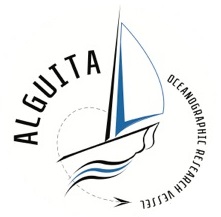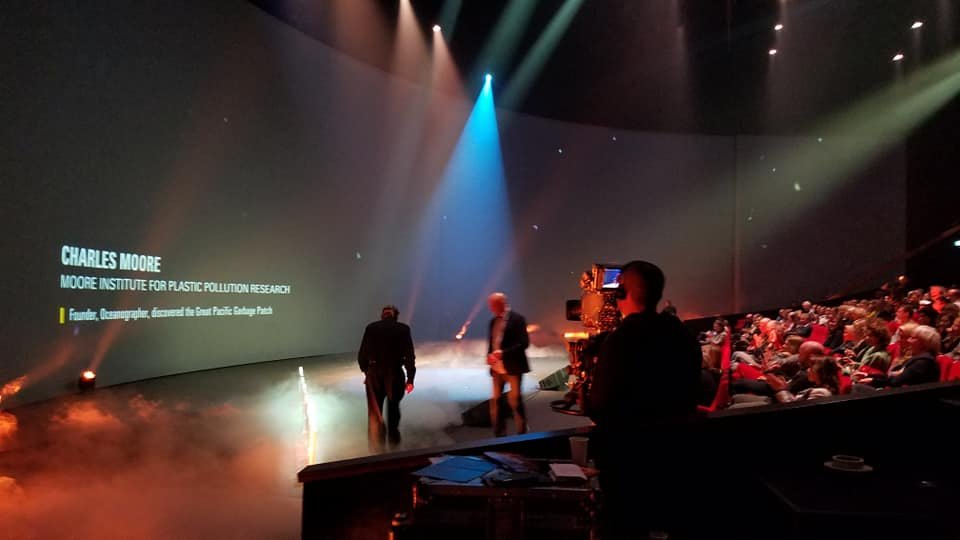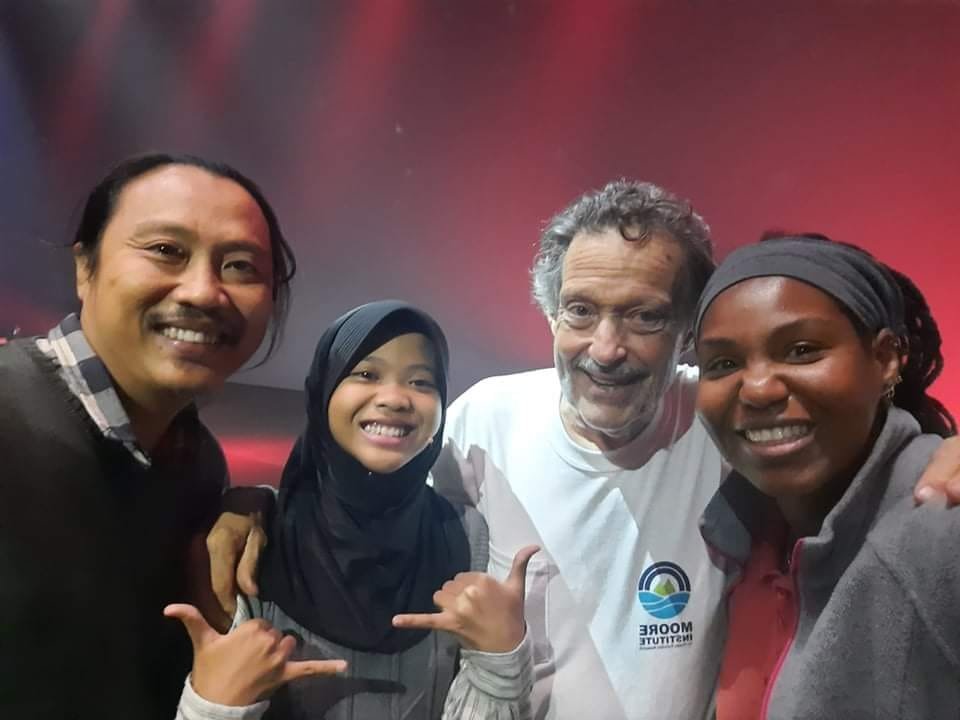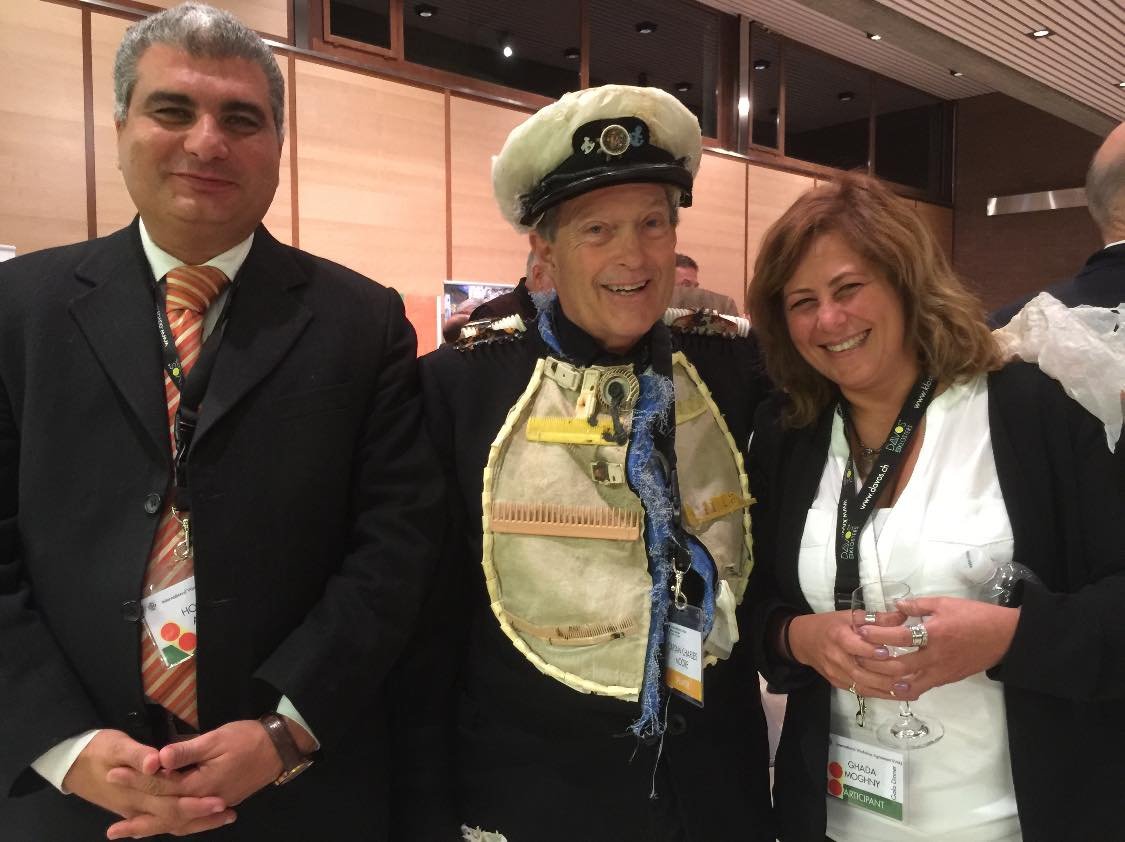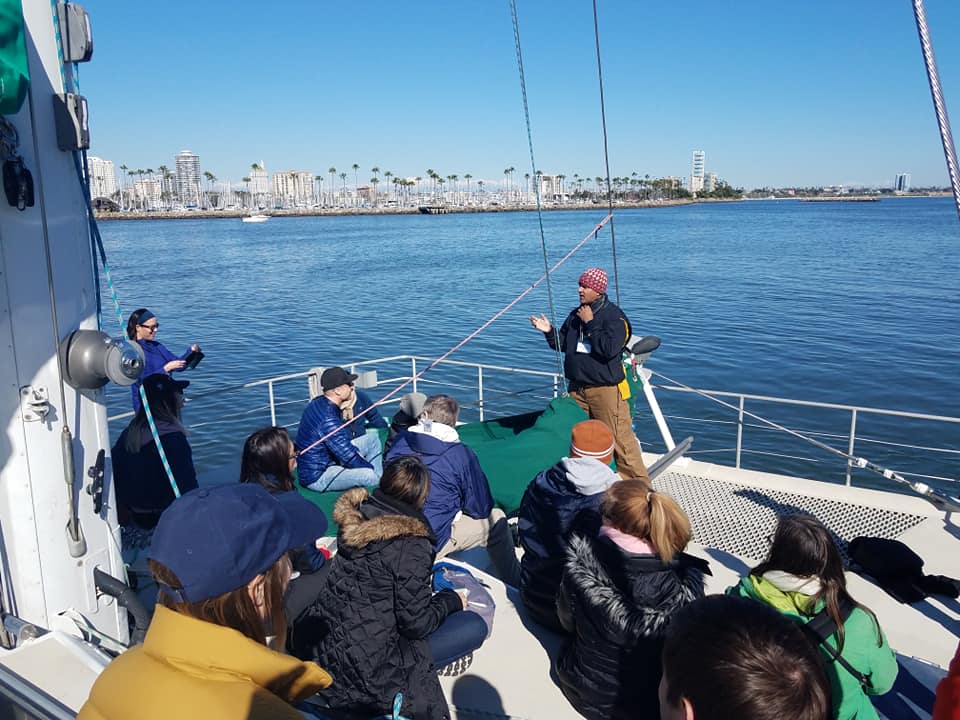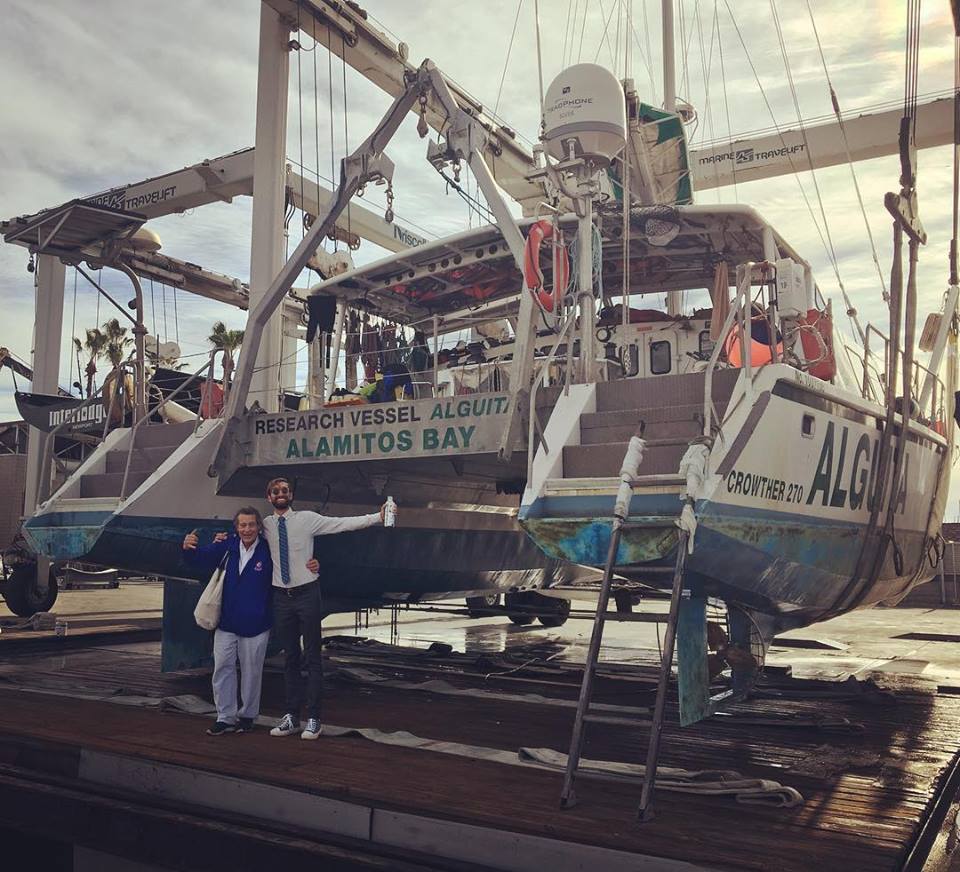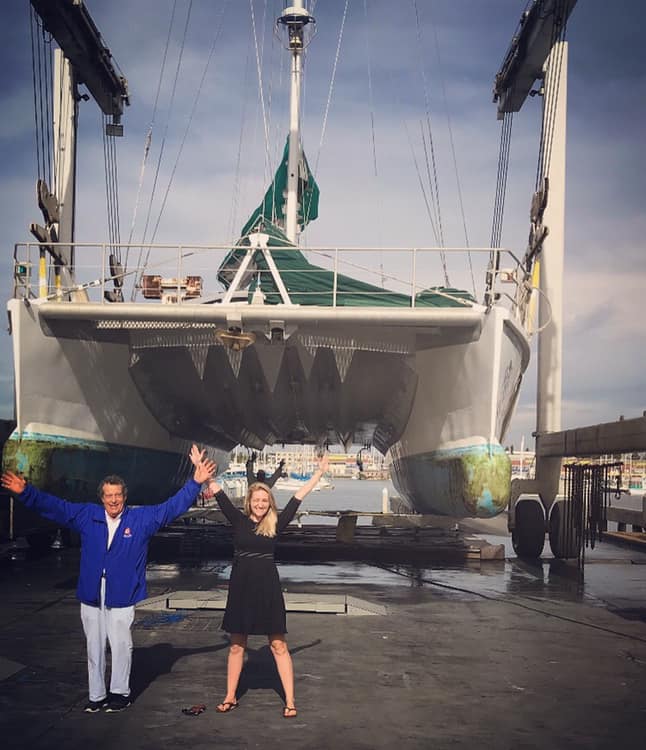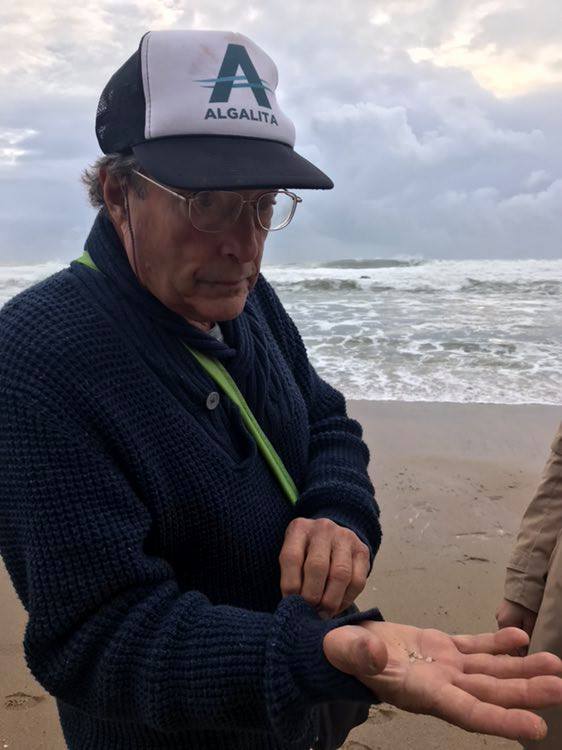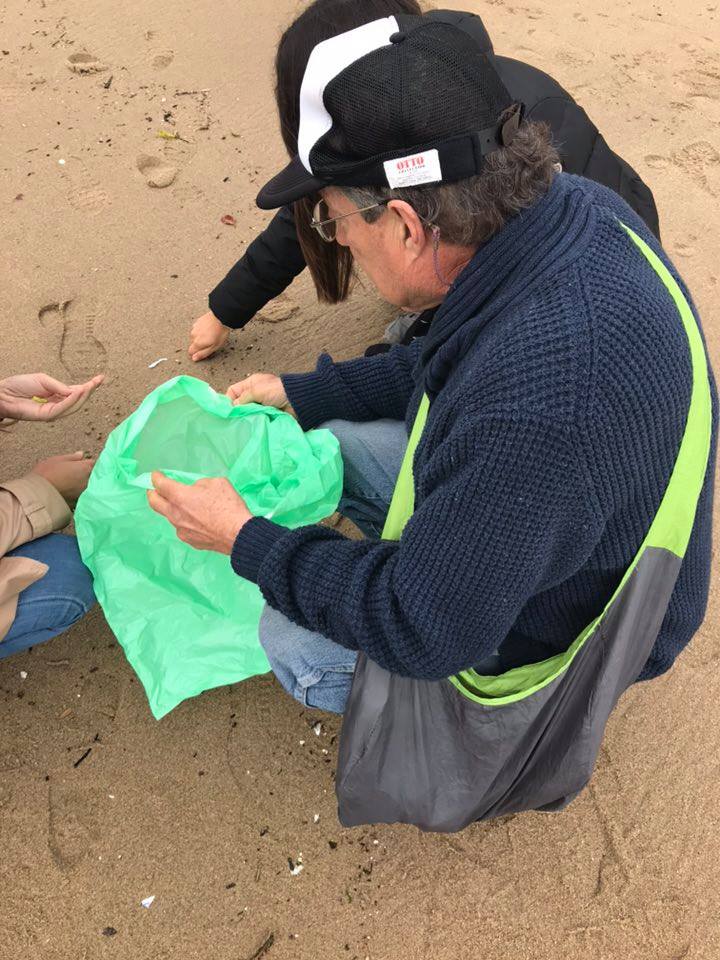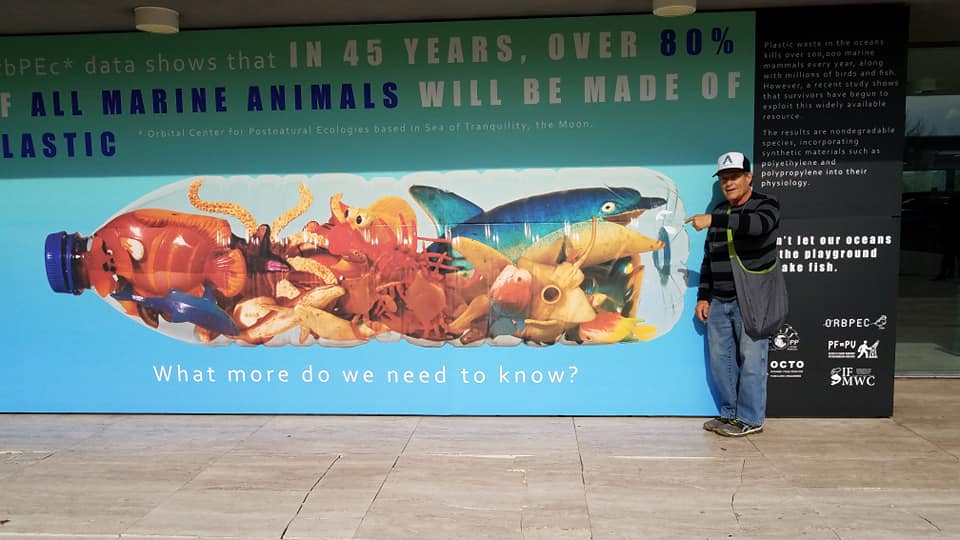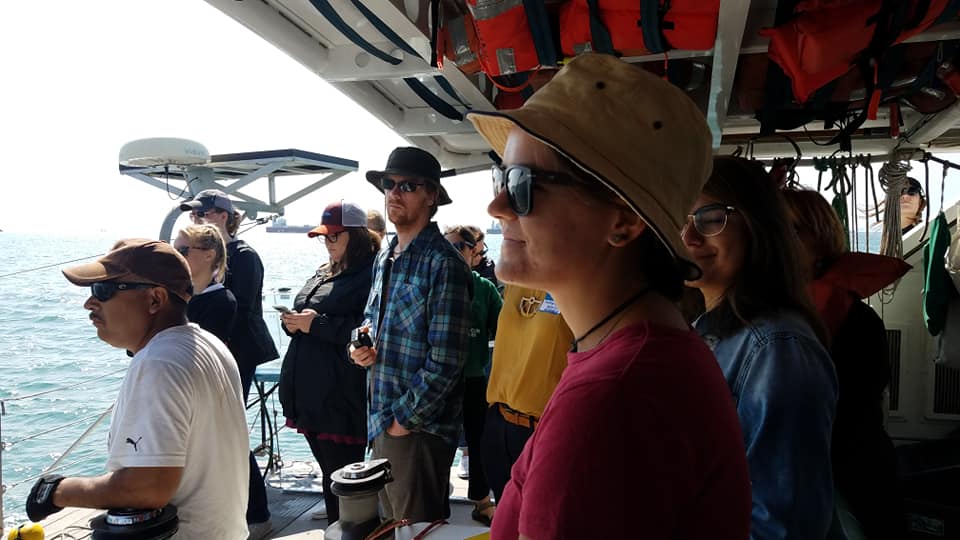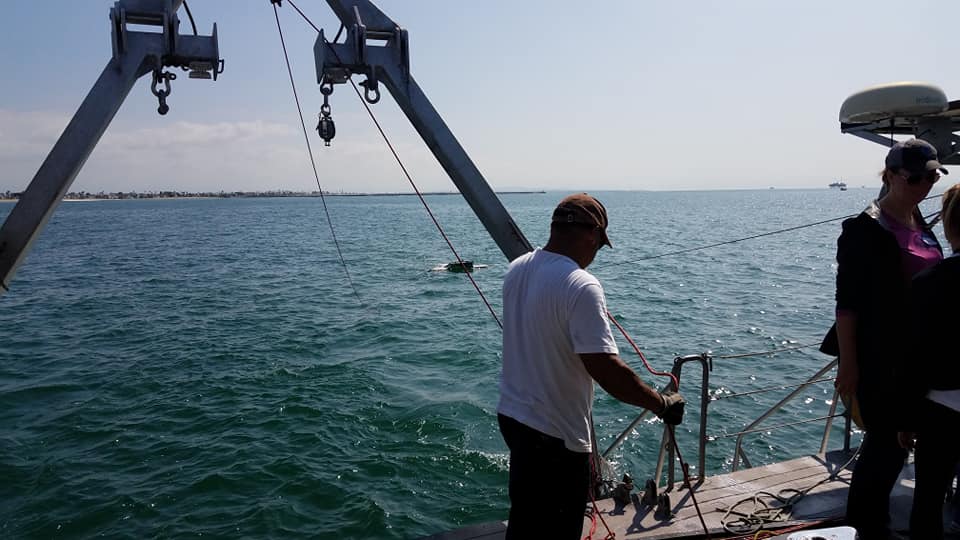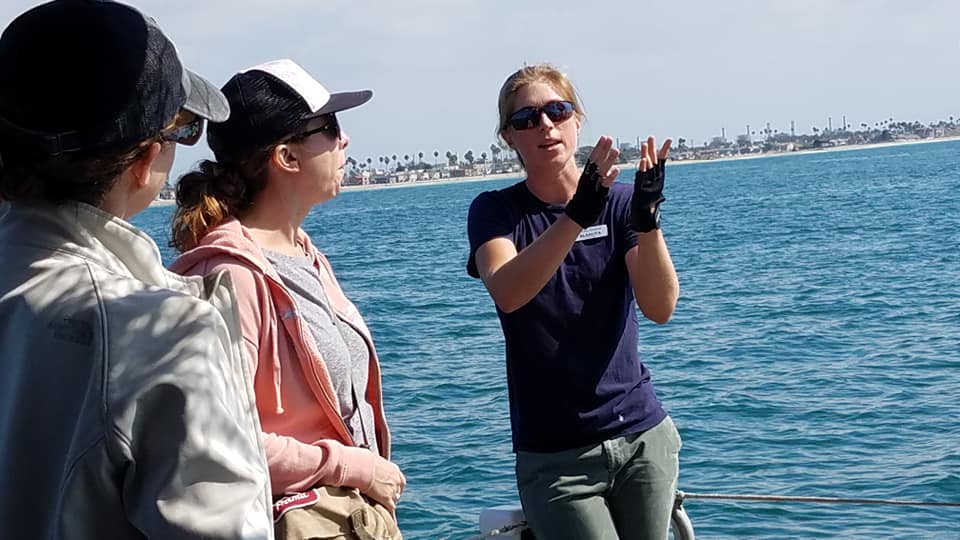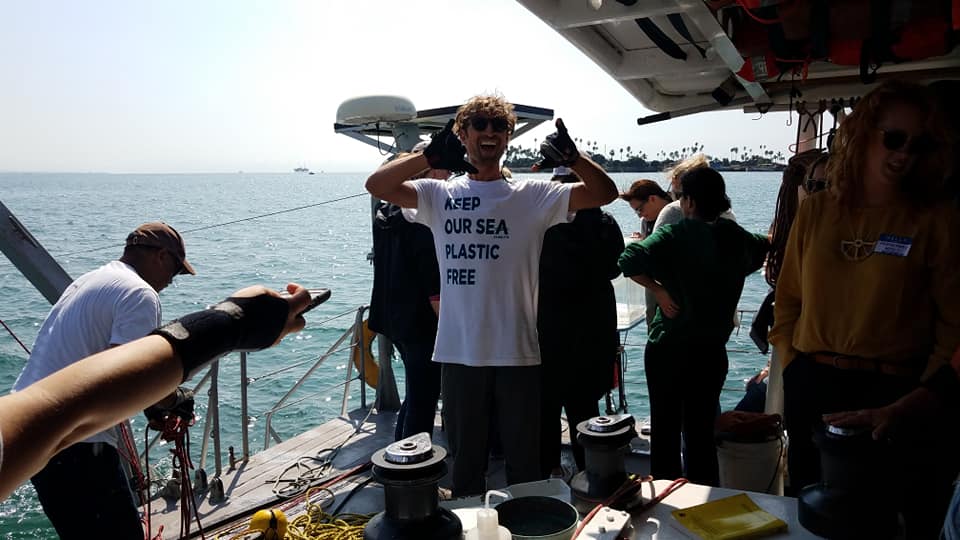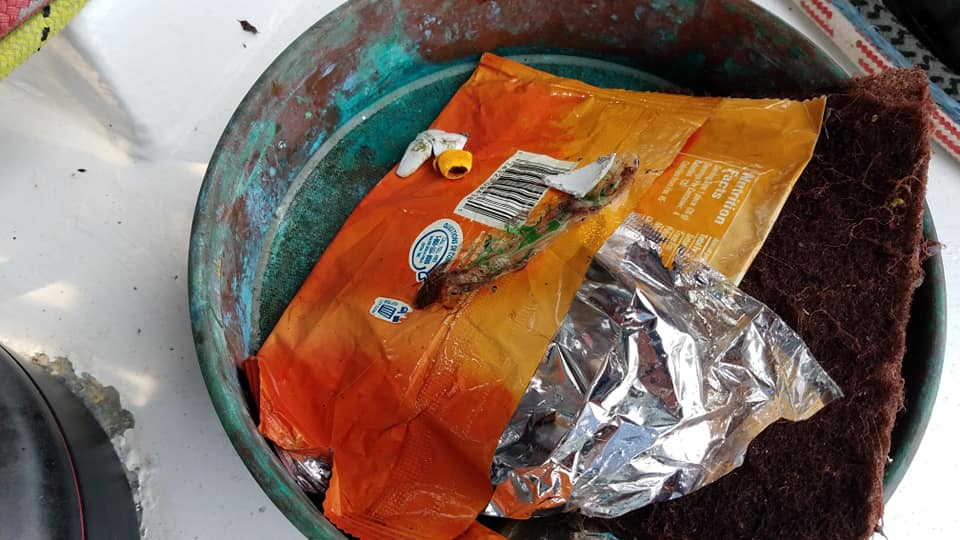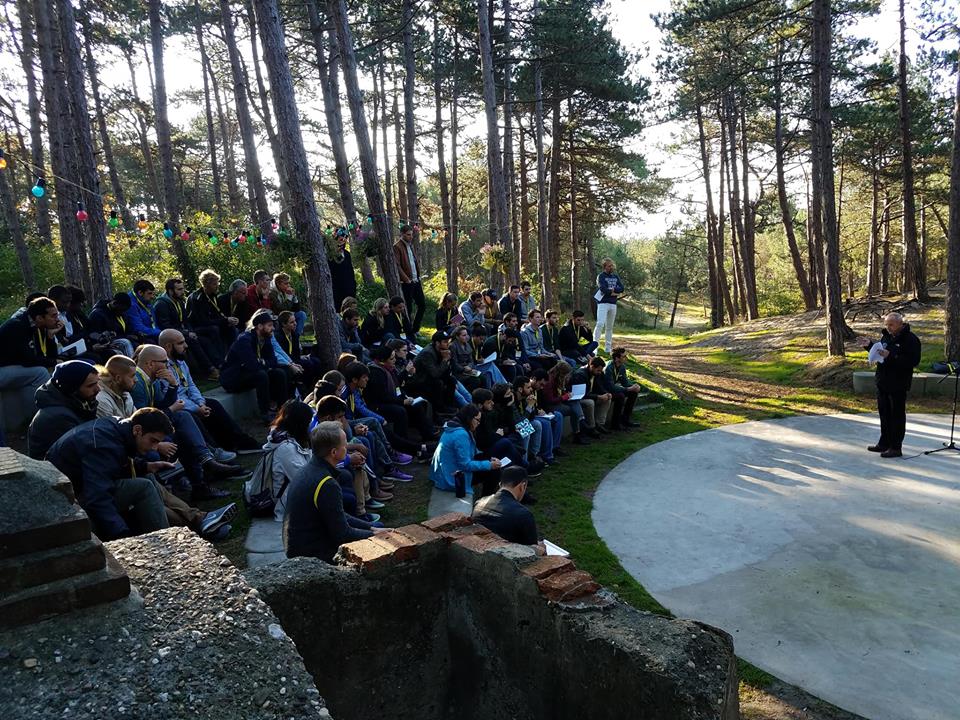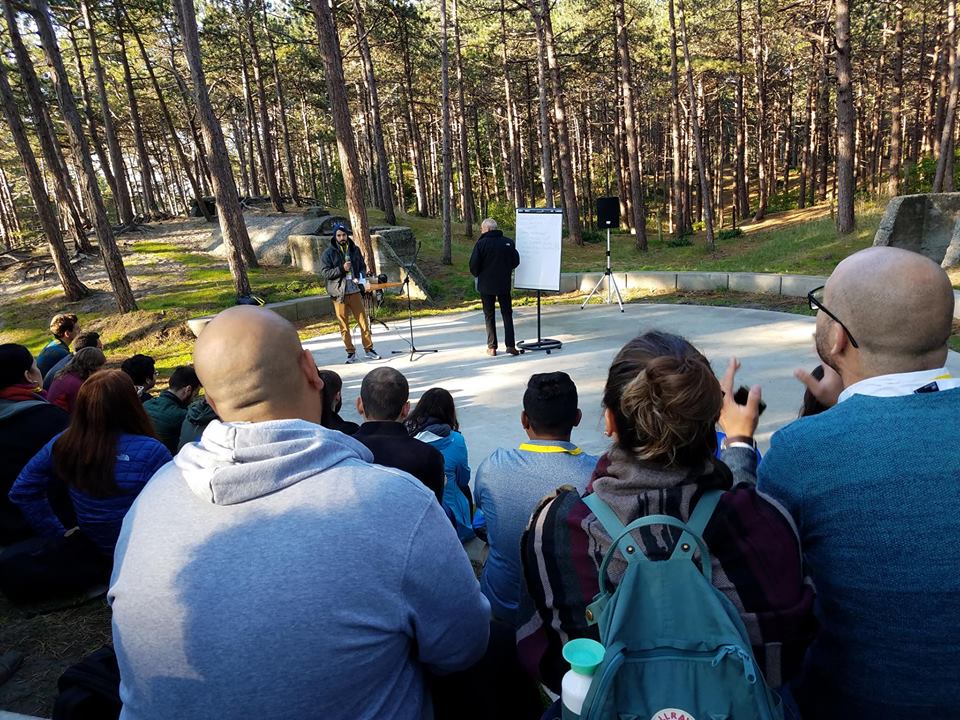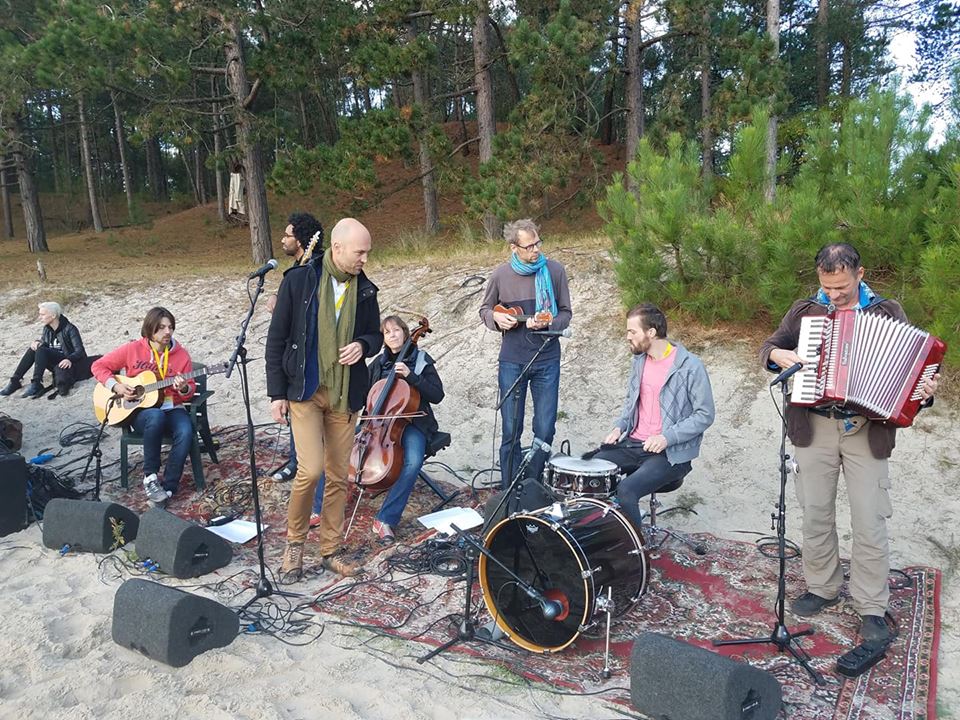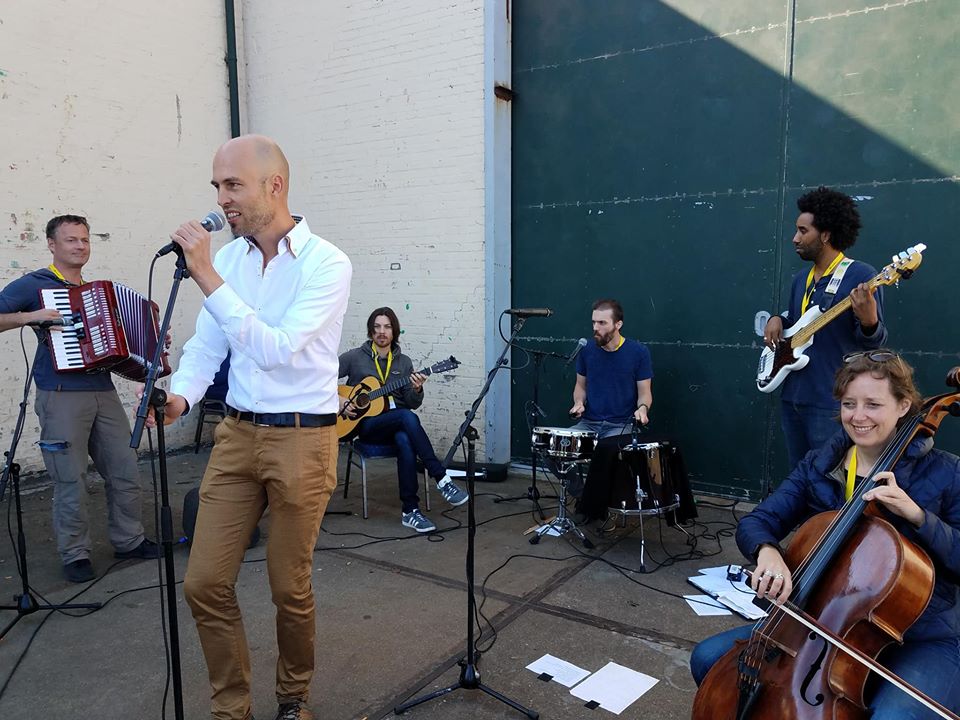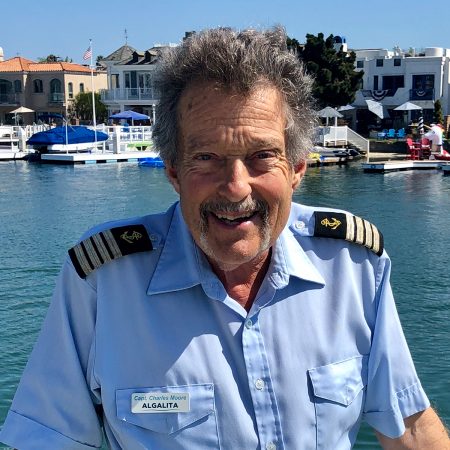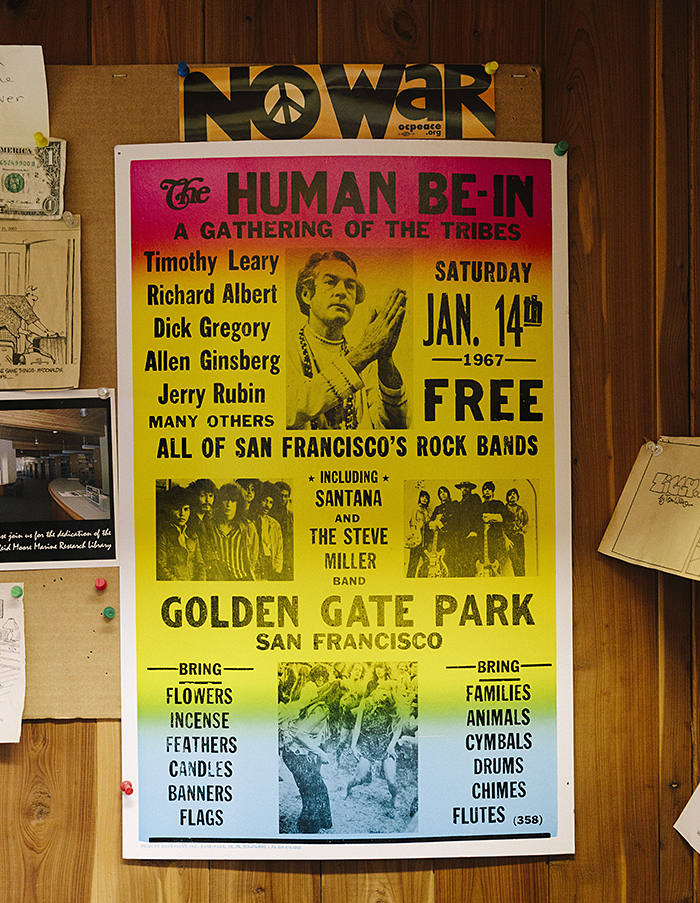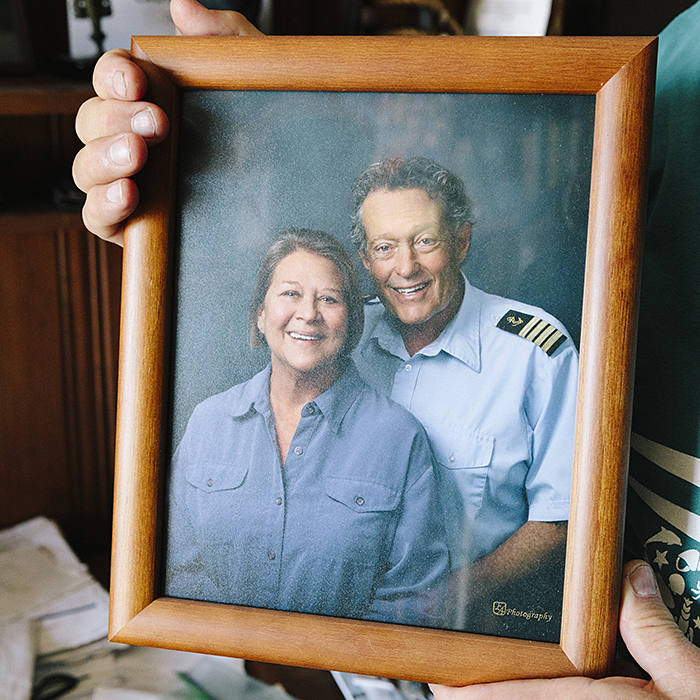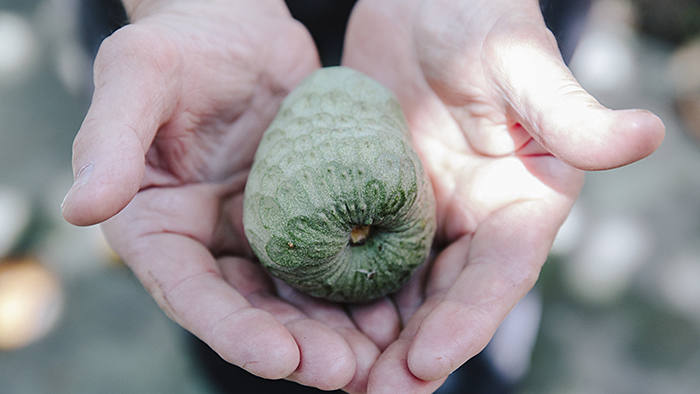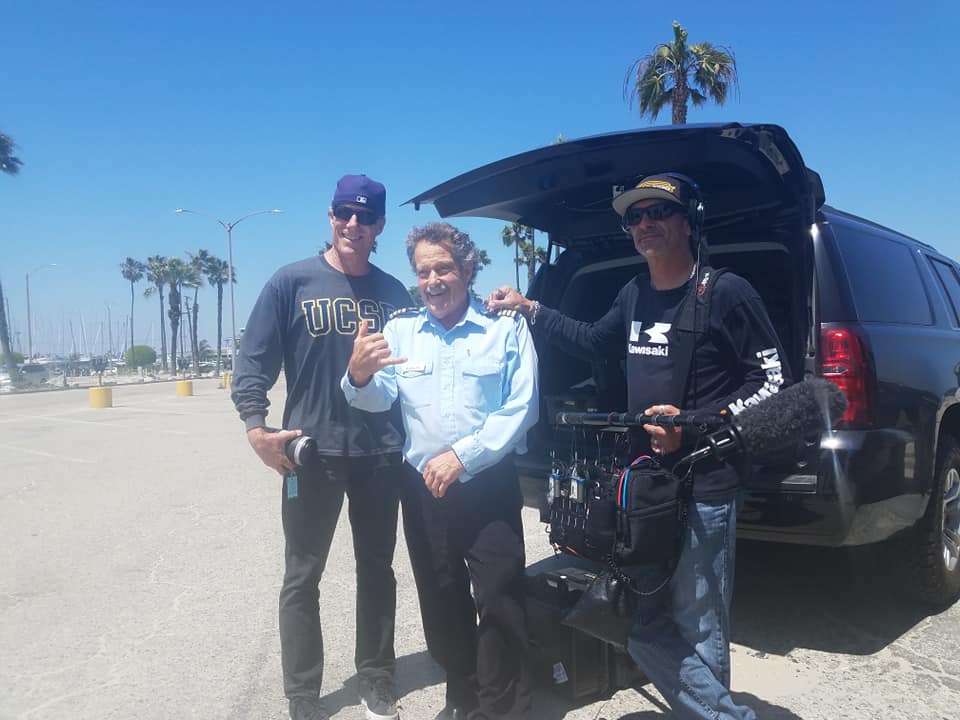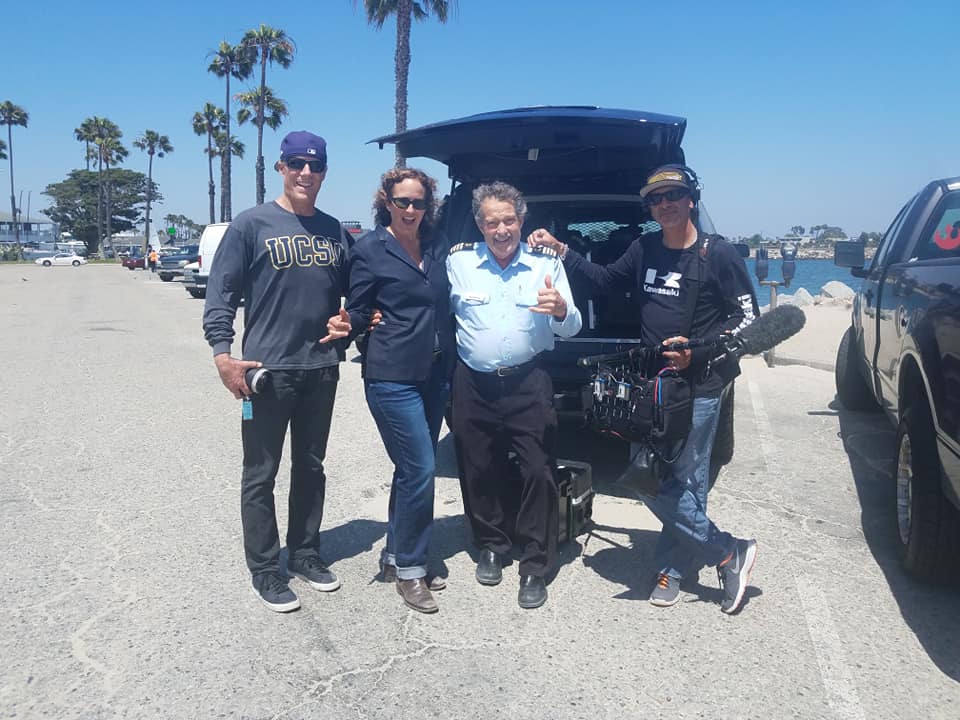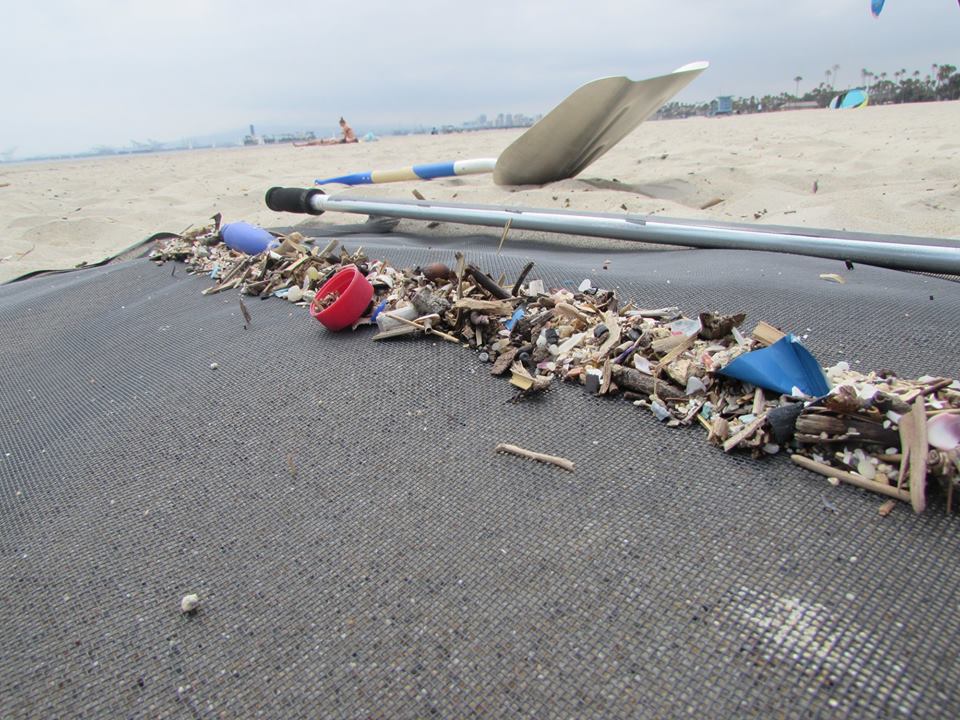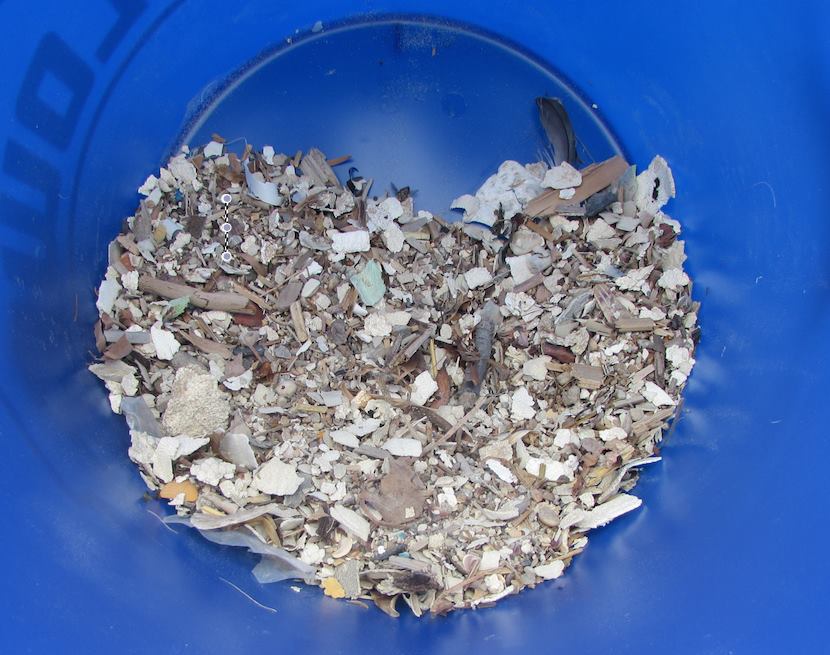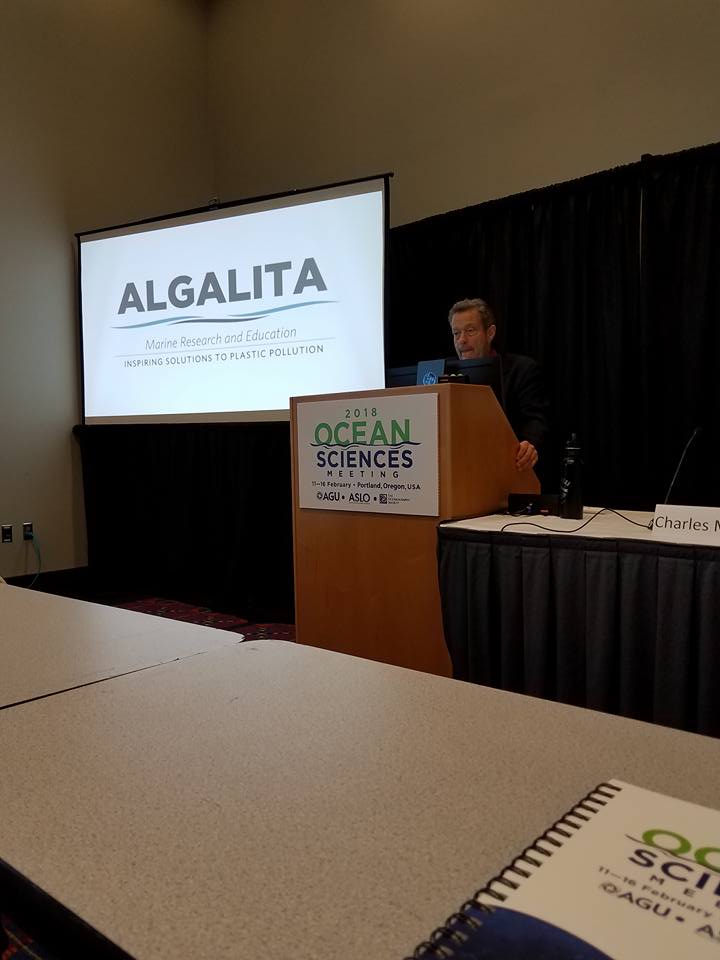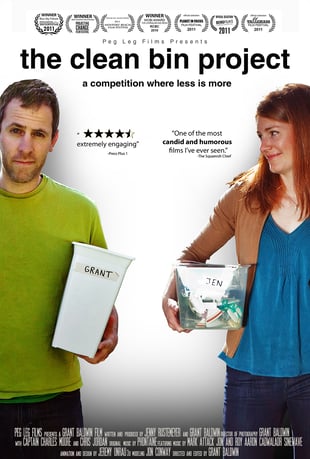A personal note..
As reported below, after 25 years plus an illustrious career in supporting my research on the impact of plastic pollution in the marine environment, it is with sadness and pride I report to you I have placed the O.R.V. Alguita for sale. As the owner/builder of the modified design Crowther aluminum hulled sailing catamaran, and its only captain and research director, I have the knowledge needed to take her new owner to the next stage of her career.She has served the scientific world well, earning her place in history as the backbone of ushering in The Pollution Conversation era worldwide.
Expeditions to the North and South Pacific and collaboration in Mexican waters, have brought attention and awareness to the world, spurring many environmental organizations to take up the gauntlet in eradicating the plastic pollution threat to our biosphere. We send her with our blessings to new adventuress and contributions to the world at large.
February 23, 2023. Report on O.R.V. Alguita in Transition
The ocean is calling you. Captain Russ Johnson and Captain Charles Moore are preparing exciting ocean voyages of discovery and research to deal with the increasing plague of plastic in the ocean that menaces her liquid realm. Let us fill you in on some of our plans.
Oceanographic Research Vessel, ORV, Alguita, designed by the well-known Australian naval architects Lock and Brett Crowther, a father and son team, is a one-of-a-kind, well-equipped, nimble motorsailer with an unlimited range. She has sailed over 150,000 sea miles. Alguita has been met and admired by naval personnel in many countries and has received permission to conduct research in Australia, Samoa, Fiji, Mexico, Chile, and the United States.
Her builder, owner, and captain for 28 years, Capt. Charles Moore has become a hero to many for his discovery of the Great Pacific Garbage Patch in 1997 and his speaking tours around the world that started the "Plastic Pollution Conversation."
Coastal and open ocean research reached an extreme low during the COVID pandemic, and the related closing of businesses and social gatherings. Sailing across the ocean during this time was not safe for the crew. ORV Alguita's captain, Capt. Charles Moore, reached out to another intrepid ocean explorer, Capt. Russ Johnson of OPDERA, www.opdera.org, who has been exploring the Great Pacific Garbage Patch for some years, providing research opportunities aboard his sailing vessel, Blue Moon, and his nonprofit - Ocean Plastic Debris Education Research and Awareness (OPDERA).
Russ and I envision a new phase of research for ORV Alguita that combines the resources of Captain Moore, the organizations Algalita Marine Research and Education, and those of Capt. Russ Johnson and OPDERA. Now you can experience the Great Pacific Garbage Patch, and you can help others to experience it too.
Together with you, we will create ocean experiences that increase awareness of the ocean's fragility. We know what it is like to sail in the Great Pacific Garbage Patch, and you can too. We want you to experience sailing in the Great Pacific Garbage Patch because we have found that only direct experience of the plastic plague in the middle of our precious ocean can awaken the sense of urgency of all to act and stem the flow of plastic that accumulates in the world's oceans.
You can help, and you can help others too. We are looking for donors to transition ORV Alguita from Captain Moore to the nonprofit OPDERA to begin the next phase of our campaign to push back against the Plastic Attack.
“Trash Taxonomy Tool: harmonizing classification systems used to describe trash in environments” An important paper by Dr. Win Cowger, Research Scientist and member of The Moore Institute for Plastic Pollution Research Laboratory.
May 26, 2022 Watch this Nippon TV Report on Plastic Pollution
Earth Day 2022. Great to be honored on Earth day by CA State Senator Lena Gonzalez along with legendary community activists, Laura Som, Alex J. Norman, and Marc Coleman at the 7 acre Urban Farm, The Growing Experience in North Long Beach! Talked planet ocean plastics during my brief talk at the end of the presentations.
January 6, 2022. YEAR-END 2021 SITE VISIT REPORT. As we usher in 2022, we reflect on yet another challenging twelve months. Looking forward to the new year with my colleagues at the newly formed The Moore Institute for Plastic Pollution Research, we will continue to pursue our research with resolve in creating an atmosphere of recovery and continued focus on the health of our oceans and the environment at large.
During 2021, the website received 8,148 visits, a major increase from 5,942 the previous year. 7,160 of these were unique visits which are defined as the same user returning after several days have passed.
There were 12,731 page reviews, approximately 2,000 more than in 2020. The most popular pages this year were is the Oceanic Research Vessel, O.R.V.Alguita and Captain Moore, followed by History, Plastic Ocean, the book and The Great Pacific Garbage Patch.
As in the past, approximately 90% have visited the site more than once over time. The number of annual visits has increased significantly. It is noteworthy that the United States has greatly increased awareness and interest in plastic pollution and there has been a shift in volume of visits worldwide with the United States heading the list.
The 113 countries are listed in order of country visit percentage: United States, Great Britain, Canada, Italy, Australia, France, Germany, The Netherlands, Singapore, China, Republic of Korea, Japan, Brazil, India, Spain, Mexico, Switzerland, Russia, Maylaysaia,New Zealand, Portugal, Sweden, Austria, Belgium, Chile, Philippines, Argentina, Denmark, Hong Kong, Estonia, Indonesia, Ireland, Taiwan, Poland, Croatia, South Africa, Ukraine, Finland, Romania, Turkey, Israel, Peru, Thailand, United Arab Emirates, Kenya, Vietnam, OTHERS, Bangladesh, Colombia, Cost Rica, Greece, Hungary, Kuwait, Puerto Rico, Saudi Arabia, Slovak Republic, Egypt, Pakistan, Bulgaria, Chechnya, Guam, Iran, Nigeria, Norway, Qatar, Uruguay, Dominican Republic, Jamaica, Latvia, Bolivia, Ivory Coast, Ecuador, Guatemala, Hashemite Kingdom of Jordan, Republic go Lithuania, Luxembourg, Montenegro, Malta, Oman, Slovenia, Trinidad and Tobago, Unknown numbers: Albania, Armenia, Aland, Azerbaijan, Brunei, Belarus, Central African Republic, Cyprus, Georgia, Honduras, Iraq, Iceland, Kazakhstan, Laos, Lebanon, Santa Lucia, Morocco, Monaco,
October 21. The October Plastic Health Summit in Amsterdam was a huge success!. Please watch my Keynote Address. All of the presentations were videoed and cab be viewed on the Foundations’s YouTube channel. Great to be united again with beautiful activists pushing back against the Plastic Attack! Goldman Prize winner Crystal Ambrose of Bahama Plastic Movement and Prigi Arisandi's family working to stop export of Plastic Waste to Indonesia. @ Plastic Health Summit. With Ghanda Moghny and Hossam Allam and Tiffany Senmoy Davy,
July 28. Exciting news! Next Wednesday, July 28th we will be on Instagram Live with Zero-Waste Chef, our director Shelly Moore, & our founder Charles Moore. Join us to hear about our research & how it relates to the zero waste movement!
#zerowaste #research #PlasticFreeJuly #stem — with Charles Moore and Zero-Waste Chef.
June 23. This Wednesday, at 3:30pm Los Angeles/Tijuana Time, I'll be giving a talk about the Plastic Age and the plague that creates in the ocean, earth and air. It Can be seen on American Corners Facebook page: americancorneruta. It is sponsored on Facebook by American Corners page: American Corners. Pictured below is Arica, Chile's famous surfbreak, El Gingo known as the Chilean Pipeline.
February 15. Battle Against Plastic Pollution Continues In Long Beach! 2021 marks the 12th year Algalita Marine Research and Education has hosted its Annual International Youth Summit on Plastic Pollution. Traditionally. Students between the ages of 11 and Institute 20 from across the globe have attended in person at the Ocean Institute in Dana Point, California. This year, starting on Wednesday, Feb. 24, students will have the opportunity to gather virtually and brainstorm on ways to solve plastic pollution . Read the Grunion Gazette article
November 30. PRESS RELEASE ANNOUNCEMENT. The Moore Institute for Plastic Pollution Research is now fully engaged in its two initial projects and is currently seeking research funding. Please visit the website to learn more and how you can take part in supporting this new field of study. mooreplaticresearch.org
September 15. Great article on Nurdles by Myron Levin in the publication Fair Warning. Tenacious Citizens Take on the Plastics Industry Over an Insidious Pollutant -
October 1. Interview on Plastisphere Podcast with Anja Krieger, Freelance Journalist.
August 9. Article by Lori Mendez, Attoeney , in . Times of San Diego, Local News and Opinion for San Diego
Opinion: San Diego’s Iconic Beaches Deserve Our Support to End Plastic Pollution. POSTED BY EDITOR ON AUGUST 8, 2020 IN OPINION | 305 VIEWS
BY LORI MENDEZ. From our shared border with Mexico to our county’s northernmost point, with the Pacific Ocean as our backyard, San Diego is known for its beautiful beaches. Yet, there is something insidious happening.
Trash that has been pulled from the Tijuana River lies in a pile, waiting to be collected and carted away . At the rate of one trash truck full per minute all day long, every day, plastics mostly only used one time, then thrown away, are making their way into the ocean. They flow there via the Tijuana River, other rivers and estuaries, and storm drains. It happens all over the world, but the problem is worse in developing countries, the same places where we ship our plastic trash.
Developing countries lack the infrastructure to handle the sorting and disposal of these items properly. Surprisingly, despite that recycling symbol that leads us to believe otherwise, only around 9% of all plastics ever made over the past 70 years have been recycled.
Capt. Charles Moore, the discoverer of the North Pacific garbage patch, a researcher, educator, and author of “Plastic Ocean,” tells us there is no “away” with plastics. Once produced, these human-made materials never leave our planet. Plastics mostly come from CO2-producing, cheaply fracked fossil fuels, and are made with petrochemical-derived synthetic plasticizers.
Many are known carcinogens and endocrine disruptors. Designed to last for decades, but thrown away after only one use, they are not easily biodegraded in and by nature. Instead, they break down into tiny micro and even tinier nano plastics that absorb other toxic pollutants.
We must break our addiction, from “to go” containers and plasticware, plastic coffee cups, lids, sachet packets, water bottles, straws, wipes, cigarette butts, plastic bags, and the like. These items are wreaking havoc on beaches worldwide, the ocean, and our entire planet.
Plastics of all shapes and sizes are choking and killing wildlife. Remember the news, Internet photos, and YouTube videos of the dead whale washed up after swallowing 200 plastic bags, that poor turtle with a straw stuck up its nose, and an Albatross chick with a belly full of lighters and Coca-Cola bottle caps?
Plastic pollution is everywhere, in the deepest parts of the ocean, at both poles, and on land in our neighborhoods, city centers, parking lots, local and national parks, and on the side of all roads and freeways. If you look anywhere, you will see it!
Sadly, all of that plastic that has been shipped “away,” dumped, or made its way to the center of the ocean finds its way back to us, humans. As Sen. Tom Udall points out, each of us now consumes a credit card worth of plastic each week in the food we eat, the water we drink, and the air we breathe. Plastics are also in our soil and in the falling rain and snow.
We consumers cannot fix the problem ourselves. The problem is that the plastic production faucet is already turned on full blast. There’s no “away” for the plastics we’ve already produced and discarded since the 1950s. The new ones keep spewing out of the faucet faster and faster, more and more. In our gorgeous backyard, the bathtub is spilling over plastics everywhere, and into our life, sustenance, recreation, and peace-of-mind-giving ocean, with no end in sight. At this rate, in just five years, for every three pounds fish in the sea, there will be one pound of plastic!.
We can scour the beach and pull plastic pieces out of the ocean all we want. Still, we cannot stop the plastics from flowing into the sea at an ever-increasing rate, unless we tackle the supply-side of plastics head-on. The only way to stem the tide of plastic pollution is by turning off the faucet! We need to “break free” from once used, throw-away plastics. We need to do this now!
Please call, write, or tweet your representative and senator today. Please ask them to co-sponsor and support the federal Break Free From Plastic Pollution Act of 2020. This novel bill will tackle the most common forms of plastic pollution while saving taxpayers and municipalities billions in inadequate and unsustainable cleanup efforts and holding large corporations accountable for their waste.
Lori Mendez is a San Diego attorney who has a masters degree in marine biodiversity and conservation from the Scripps Institution of Oceanography.
OPINION: SAN DIEGO’S ICONIC BEACHES DESERVE OUR SUPPORT TO END PLASTIC POLLUTION was last modified: August 9th, 2020 by Editor
BREAK FREE FROM PLASTIC POLLUTION ACT
(Senator Tom Udall, Congressman Alan Lowenthal, Algalita Director of Partnerships - Michael Doshi)
Last week in Washington D.C., alongside our Congressional District Representative, Alan Lowenthal (D-CA), and Senator Tom Udall (D-NM), Algalita proudly introduced the Break Free From Plastic Pollution Act of 2020, a comprehensive and historic bill aimed at stopping the plastic pollution crisis.
The Act will provide essential NATIONAL leadership that is badly-needed - reducing the amount of wasteful plastic and reforming our broken waste and recycling systems. It will shift the burden from municipalities focusing on cleanups to where it belongs - to the corporations that produce this waste:
Require big corporations to take responsibility for their pollution, requiring producers of plastic products to redesign, manage, and finance waste and recycling programs.
Spur innovation, incentivizing big corporations to make reusable products and items that can actually be recycled.
Create a nationwide beverage container refund program, which has been proven successful at the state level.
Reduce and ban certain single-use plastic products that are not recyclable.
Establish minimum recycled content requirements for beverage containers, packaging, and food-service products, while standardizing recycling and composting labeling.
Spur massive investments in U.S. domestic recycling and composting infrastructure, while pressing pause on new plastic facilities until critical environment and health protections are put in place.
Prohibit the U.S. from shipping plastic waste to developing countries that cannot manage it.
This bill changes the narrative of plastic pollution from being an onus on consumers to focusing on the multi-national brands that produce the plastics in the first place. We are proud that Congressman Lowenthal and Senator Udall engaged stakeholders across the entire plastics value chain, working hard to incorporate environmental justice solutions.
A few days ago, I participated in an online discussion with Planet Stewards. Some of the questions posed to the group included “Under what scenario (political, social and economic systems) could recycling become the solution to plastic pollution?” and “Will crises forever be the driver of fundamental economic, political and social change? If so, what will be the crisis with plastic pollution that forces radical change?” Here are a few excerpts. Please allow for pauses between questions and outside noise..
A BRIEF JOURNEY BACK IN TIME . 2019 was filled with my continued participation in global zero waste conferences, youth environmental activism,scientific conferences, symposia, Algalita’s 8th Annual International Plastic Pollution Solutions Youth Summit and publication of two new papers.
The major event of the year was the Korean Broadcasting System charter of the ORV Alguita for a documentary expedition on plastic pollution in the marine environment. This voyage highlighted the need for further research on the ecological consequences of turning a continent sized area of ocean into a floating plastic dump.
The plastic pollution plague has gained a foothold that can only be stemmed with the cessation of debris entering our waterways and getting to their final resting place …..our precious oceans. The profound sadness of our folly over the last 50 years is expressed by the Expedition’s First Mate, Raquelle de Vine, Algalita’s South Pacific Executive Director in New Zealand, as seen in this video. If only every eye in the world could see this and the destruction it is reigning in the marine environment and on its inhabitants, the world at large would band together to save the oceans and keep them from turning on us…they’re angry.
February 12, 6th Annual Zero Waste Symposium. San Diego
February 22-24. The 8th Annual Algalita Plastic Pollution Solutions International Youth Summit. A huge success! From Stiv Wilson, Inspirational Speaker at the Conference “The thing I want to tell you all is the most powerful testimony always comes from the voice of youth…”.
March 22. The Plastic Soup Foundation is headquartered in The Netherlands. I have worked closely with the organization for several years. This is an extremely dedicated group who have made major contributions to the eradication of plastic pollution. On March 22, a press-conference was held about the 15 ground-breaking research projects on microplastics and health, appointed by ZonMw, the Dutch organisation for health research and development. This is the first time that a large scientific consortium starts researching the effects of micro- and nanoplastics on human health. The press was informed about the 15 pioneering research projects and we've divided these into the following 4 categories: Immunology · Brain and Placenta Lung · Intestines
March 26. Gray Lab at UC Riverside. A microscope was placed in the forced air bubble at the Gray Lab at UC Riverside during dissection of our Myctophids. This ensured no airborne fiber contamination of our samples.
May 22. On May 8 as part of ‘The Conference in Europe/Portugal’, I was fortunate to be interviewed for the Good Morning Portugal segment "Go Green" in the beautiful Estufa Fria Arboretum in Lisbon.
May 30. “A Solution to Plastic Pollution First International Online Summit ” Coaches and ambassadors of a healthy, sporty, spiritual and happy lifestyle in harmony with nature. I was joined by Jo Ruxton, co-producer of “A Plastic Ocean’ and Maren Hövel, expert on sea turtles with plastic diseases.
September 21 - 24. Wilmington, North Carolina. Plastic Ocean Project Headquarters and Laboratory Re-opening,University of North Carolina at Wilmington. After suffering the loss of their new lab in Hurricane Florence, we celebrated its new opening. Congratulations to Bonnie Monteleone, Director of Plastic Ocean Project . The Karen Beasley Sea Turtle Rescue and Rehabilitation Center from Surf City, North Carolina, Dijereedoo, completes their duet . Playing their whale sounds for the turtles is great therapy as it seems to calm them. I had the pleasure of speaking at this well attended event. After Plastic Ocean Project's grand opening, Lesette Campbell and I do some QA/QC on Plankton sorted from plastic. I was also privileged to have a life-size likeness of me as part of their new lab. Volunteers at the Plastic Ocean Project make a great contribution to this organization.
October 7-9 Bilbao, Spain. International Solid Waste Association (ISWA World Congress). I gave my presentation speech "Invasion of the Biosphere by Synthetic Polymers." to the International Solid Waste Congress
October 13. Long Beach, California. Algalita’s 25th Anniversary Celebration. Reflections of the past 25 years were enjoyed by attendees from Algalita Board Members, current and past, scientists, staff and friends new, and those who have been with us for many years.
October 24 - 27. Zero Waste Youth Global Meeting, Cascais, Portugal. An excellent youth conference! The attendees wore t-shirts that said “..not the hope..the ACTION…” My "Why Zero Waste" presentation was well received and I was glad to have the opportunity to participate.
NEW PUBLICATIONS
Microplastics: Sources and distribution in surface waters and sediments of Todos Santos Bay, Mexico. Science of the Total Environment Volume 703, 10 February 2020, 134838 Nancy Ramirez-Alvarez, Lorena Margarita Rios Mendoza,Jose Vinicio Macias-Zamora, Lucelro Oregel=-Vasquez, Arturo Alvaraez-Aguilar, Felix Augusto Hernandez-Guzman,Jose Luis Sanchez-Osorio, Charles James Moore,Hortencia Silva-Jimenez, Luis Felipe Navarro-Olache 2019.
C.J. Moore. 2019 Invasion of the Biosphere by Synthetic Polymers: What our current knowledge may mean for the future. Acta Oceanol. Sin., 2019, Vol. 38, No. 5, P. 161–164 https://doi.org/10.1007/s13131-019-1424-4
INTERVIEWS
February 5. ReD Associates Interview. This social science-based strategy consultant group is conducting a study on behalf of a global sportswear company to study of the effect of citizen activism on corporate strategies. The interview was done with Lara Casciola and focused on Captain Moore’s observations of the public’s response to the plastic pollution issues from their awareness and action perspectives.
April 17. A live interview with Captain Charles Moore by Spectrum’s Parker Collins “WAVES OF CHANGE”. Long Beach Researchers Pioneering Microplastic Research.
May 8. as part of The Conference in Europe/Portugal, I was also fortunate enough to be interviewed for the Good Morning Portugal segment "Go Green" in the beautiful Estufa Fria Arboretum in Lisbon.
September 17. interview for KPCC on the topic of “Covering Climate Now’ with local host , Nick Roman of “All Things Considered”..
ARTICLES and PRESS RELEASES
August 27. Anthropocenic Plastic. A good article in Spanish in La Jornada California by Horacio De La Cueva, a colleague and former Director of CICESE, a Mexican Research Institute..(Translation is available by clicking on the translation block at the upper right of the article).
June 11. Some alarming news from the Science Editor’s Desk of The Telegraph in London. “Average person swallows plastic equivalent of a credit card every week, report finds”
PRESS RELEASE: PLASTIC POLLUTION IN THE NORTH PACIFIC GYRE WORST EVER SEEN
LONG BEACH, CALIFORNIA. August 2, 2019. Captain Charles Moore, aboard Research Vessel Alguita, returns to port in Long Beach on Monday, August 5.
20 years ago he made the discovery that our Earth’s largest ocean concentrates our trash in an enormous area over 1000 miles from land. During the current expedition, scientists sampling 11 monitoring stations extending hundreds of miles, observed more plastic in the area than the associated sea life. This years’ voyage, the 11th through this area, revealed horrifying plastic pollution levels, worse than ever before seen. Observations noted by Captain Moore and crew: 1) More consumer goods compared to fishing gear; 2) Less planktonic life collected in samples; 3) More large pieces of debris; 4) More small microplastic bits.
First Mate and Executive Director of Algalita South Pacific, Raquelle Devine, stated “..the damage we have done is sickening beyond belief…” Engineer Marty Klein stated “..I found the highest concentration zone a heart wrenching sight of devastation when swimming through the freeway- like system of plastic windrows that stretch to the horizon. It’s a surreal experience---like flying through the total pulverized plastic contents of Walmart and Costco combined. My 14 years supporting university based ocean science and multiple trips offshore with Captain Moore did not prepare me for the horrific extent of this permanent killing presence, through which I could not swim deep enough to escape. We need to immediately change our relationship with this dangerous material…plastic”.
It is Captain Moore’s opinion this current return to the North Pacific Gyre is the most important research expedition he has ever conducted.
PRESS RELEASE: UP CLOSE AND PERSONAL…A DOCUMENTARY ON 20 YEARS OF “PATCH” RESEARCH
LONG BEACH, CALIFORNIA. July 11, 2019 CAPTAIN CHARLES MOORE AND THE ORV ALGUITA will once again take to sea for “The Great Pacific Garbage Patch” on July 14. This expedition, unlike the ten that preceded it, is a charter by the Korean Broadcasting System to create a documentary about our 20 years of research in “The “Patch” and to sample its center. Their mission is to provide an up close and personal experience of the painstaking, meticulous work that has been accomplished, resulting in irrefutable data shared with the world to provide awareness of the plague that plastic accumulating in this area has caused.
During the three week voyage, we will also sample the center of accumulation of debris based on the Accumulation Zone model by Nikolai Maximenko and Jan Hafner of the International Pacific Research Center at the University of Manoa ln Honolulu. Using Korea Broadcasting Systems drone, we will collect images to compare to those from satellites in order that the areas of accumulation and type of debris in a particular location can be identified and recorded from space. This has never been done before…..
If all goes well, we plan to have an at-sea meetup with Ben Lecompte of The Vortex Swim Research Project. He has swum across oceans and wanted to challenge the great Pacific While swimming from Japan to Hawaii, he switched his focus of setting swimming records to fighting the plastic plague in our precious oceans after finding plastic every single day while swimming. Read more……
March 21. GRUNION GAZETTE ARTICLE. Algalita Leads Fight Against Ocean Plastic By Amy Orr, Contributor
Last October, a 2,000 foot-long unmanned device was towed and positioned in the Pacific Ocean 1,200 nautical miles from the coast of California. System 001, or Wilson, as it was affectionately called, was outfitted with solar powered lights and communication devices, but its basic design was simple. Below a u-shaped structure of enormous floating tubes, a 10-foot skirt hung in the water to catch and collect some of the 1.8 trillion plastic pieces in the “Great Pacific Garbage Patch”.
“Many people think of the Great Pacific Garbage Patch as an island”, Algalita Executive Director Katie Allen said, “but it’s actually a large, shifting area of confetti-sized pieces of plastic. The Patch does contain some larger post-consumer products with rigid durability, like buckets, toothbrushes and bottle caps, but most of the pieces are microplastics so the area is more like a plastic soup.” System 001 was built in Alameda by The Ocean Cleanup, a non-profit organization headquartered in The Netherlands. The company was founded by Dutch Inventor, Boyan Slat, in 2013 when he was 18 years old. He is now 24. In preparation for the challenges that can arise at sea, Slat assembled a team of expert engineers to test scale models and prototypes and run computer programs. He also consulted with ocean specialists, including Long Beach resident, Captain Charles Moore. Moore, who discovered the Great Pacific Garbage Patch in 1997, is the Founder of Algalita, a Long Beach based non-profit devoted to marine research and preservation.
Algalita monitors plastic levels through regular marine expeditions. This July, Algalita will be conducting a three-week expedition to the 11 stations of the Great Pacific Garbage Patch, However, the Great Pacific Garbage Patch is not the only area of plastic accumulation in the oceans. Several such areas exist. In fact, Moore discovered another enormous patch of garbage in the South Pacific in 2017. Last May, Moore and Allen were invited to visit The Ocean Cleanup’s Assembly Yard in Alameda where the device was being staged. According to Allen, Moore did not believe the project would be successful, but he was happy to discuss the system and offer his opinions. Moore’s concerns proved to be valid. On January 3, The Ocean Cleanup towed its malfunctioning device away from the Great Pacific Garbage Patch. After only 115 days in the Pacific, System 001 returned to port.
“It’s complicated’, Allen explained.”We knew it wouldn’t work but we weren’t listened to. We would love to remove debris from the water, but the technology for removing it properly does not exist yet. Extraction is just not feasible at this time”. Guided by this principle, Algalita is focusing the majority of its efforts on preventing further pollution. The Company has made it a mission to fundamentally shift the thinking on land nd stop debris from entering the water. One of lgalita’s primary goals is to educate and empower young people to think critically and become agents for change.
For the past 10 yesrs, Algalita has collaborated with Cal State Long Beach to study the impact of plastics on Laternfish, one of the primary bait fish in this area. Last June, Algalita partnered with the City of Long Beach Environmental Services Bureau for the Great Peninsula Cleanup. in addition to gathering garbage, residents learned the difficulty of separating plastic particles from grains of sand. Last month, Algalita’s International Youth Summit encouraged students from around the world to take action against single-use plastics. To date, Algalita’s academic programs have engaged more than 2,150 teachers and 275,800 students with in-class workshops and field research opportunities. “Changing public perception is an on-going process,” Allen said.
The next major effort was for the Earth Day Coastal Cleanup onSaturday, April 2. Algalita Marine Research and Education, the Eldorado Nature Center and Clean LB teamed up with Deep Blue Scuba and 5 Gyres for a 3-site cleanup. Belmont Pier, Cherry Beach and the Peninsula. This event was another great opportunity to increase awareness about marine debris and protect the health of our coastline.
We would love to remove debris from the water, but the technology for removing it properly does not exist yet ---Captain Charles Moore
March 15 - 19. After a nice sail over to San Clemente Island with the Murrelet Monitoring Team from the California Institute of Environmental studies, we awoke to a calm sea and clear sunrise. Plenty of solar energy for ORV Alguita's kilowatt of solar panels. Green hillsides on this sparsely populated Island evidenced the recent rains.
January 30, 2019 - Driscoll Boat Works. Overhaul for her next mission. “This amazing catamaran, the Oceanographic Research Vessel Alguita, is one of the strongest and most seasoned team members on the global plastic pollution prevention team! Over 20 years ago, along with Captain Charles Moore and crew, she discovered the accumulation of plastic pollution in the North Pacific Gyre, aka the Great Pacific Garbage Patch.” …Michael Doshi. “Since then, “The Mighty Alguita” with her intrepid Captain Charles Moore, has seen action in the waters of the North and South Pacific serving in the war against plastic pollution in a continuing effort toward eradication.”
2018 - November 18. “Memorable Sunday this is! It's an honor to be able to spend it with Captain Charles Moore. The issue of the scourge of marine litter unites us. Not only did we exchange ideas about this great world problem, but we were able to catch it together. Thank you for the teachings, thank you for the loving endorsement and for the encouragement to continue!…” A quote from one of my Conference colleague speakers. I am proud to be in this company of dedicated plastic pollution eradication activists..
November 14 - 21 Facility of Sciences and Technology New University of Lisbon, Portugal. On November 16, National Day of the Sea, I will make my presentation of “20 Years in the Gyres: An Overview of Algalita’s Monitoring Programs”.
November 15. American Corners sponsored my trip to Portugal to talk about plastic pollution. Interview with local tv Independent station SIC in Lisbon.
October 15. This article, “Plastic Soup discoverer, Moore, has faith…but no good word for Boyan Slat”, was published in Trouw, a Dutch daily newspaper in Amsterdam.
“…When Captain Moore speaks, he does so while sitting at a table, bent over his text on A4 pages. He talks hard and the story unfolds so smoothly that it is clear that he has done this many times before. Once started he can not be stopped. On his white shirt, embroidered in blue, is his name: Captain Charles Moore. Moore, now over seventy, discovered the plastic soup in 1997 — a mash of large and small pieces of plastic that has, over the years, accumulated by ocean currents at a place in the Pacific Ocean. The soup is now estimated to be as big as Spain. Since the discovery, the captain has become concerned with that plastic. Last week he arrived in the Netherlands to deliver his talk at Springtij,— an annual meeting on sustainability held at Terschelling. He also gave a speech for the employees of the World Wildlife Fund at Zeist.
His PowerPoint presentation is entitled: 'Inspiring solutions for the plastic soup'. But you will have to listen very hard if you want to hear of an inspiring solution from his presentation. Moore has nothing but bad news for his audience. One after another photo appears on the screen of a turtle entangled in plastic or a cut-open albatross with a stomach full of bottle caps. Moore rattles-off depressing facts and figures along the assembly line. "Every year millions of kilos of plastic are added. There is plastic in our walls, in our carpets, our clothes. We breathe plastic, we eat it, it gets into our lungs and our brains. That can not be right. " "I do not sugar-coat," he says grinning after the presentation, when the WWF employees (some slightly disappointed) have left the room. "No sweet-talk from me."
Discovery. In 1997 when Moore participated in a sailing race to cross the Pacific Ocean in his sail-boat, he saw no dolphins nor whales. What he saw was clutter, clutter everywhere, from all over the world. I have something to do with that, he thought. Since then, with his Algalita organization, he has concentrated his research on plastic in oceans. He concluded that plastic waste ending up in the sea is driven by oceanic currents to that one place. Thus he became the discoverer of the plastic soup. Plastic provides growth, plastic makes people rich. Two years later he declared that in the plastic soup area, there is six times more plastic than plankton. He says that micro-plastics are especially a problem. Plastic does not decay, but over time, it breaks down into tiny pieces. Fish and other marine animals eat these micro-plastics and thus it ends up on our plates and in our bodies. Moore's latest research concerns Lanternfish — small fish that, according to Moore, are essential in the food chain. At night these fish come to the surface to eat plankton and they become saturated with plastic. Moore estimates that at least 35 percent of the Lanternfish is full of micro-plastics.
Solution. Once out from behind his lectern, Moore ventured into a more solution-oriented rhetoric. He says that solution is at the beginning of the chain — we have to use drastically less plastic. And what is used must be neatly processed. "We are always on the road to a world without waste," he says. "But we never arrive at our destination. Some countries and cities are already doing well. Germany, Japan, the Netherlands, San Francisco. People are working on less consumption; but there is also much burned. That is not the solution. "
How do we at least get close to that final destination? By design, says Moore. "Benign by design", doing well by designing, designing smart, with less packaging and less plastic in everyday products. "But that does not work in the current economic system. Plastic ensures growth, plastic makes people rich. Moreover, if rules against the use of plastic are laid down in one country, then every multinational takes its bags to a country where there are no such rules. We need a global solution, international cooperation. But I see no reason to assume that that will happen. " Moore is pleased with the EU ban on disposable products and the ban on plastic bags in more and more countries. "You see it working — that fewer plastic bags are found on beaches." And although he is also at the table with companies such as Coca-Cola and Dow Chemical Company, he believes in a bottom-up approach. He calls himself a grass-roots activist; of the type that took to the streets in the Sixties, last century.
Boyan Slat. The captain has the most confidence in the younger generation — in his opinion, the generation that has been disgusted by ever-growing prosperity and which can change the economic system. Says Moore: "I call them the fed-up and disgusted generation, the generation disgusted by the current system, which is fed-up with it." He gets a warm feeling from projects such as World Cleanup Day, when in a dozen countries, millions of people were picking up waste for 24 hours. He calls himself a professional grumbler, but praises the employees of his own organization who use awareness and educational programs to encourage young people to work for a world with less plastic. But if it's possible to drastically reduce the use of plastic, millions of kilos still float in the ocean. Moore is resolute about that: clean-up is not possible. "You can not solve this with a fancy, large vacuum-cleaner," says Moore.
Although the Captain has hope in the younger generation, the young Dutch inventor Boyan Slat is not included. Slat has been working for years on a project to clean up the plastic soup with large floating arms. Whether that will succeed is still questionable, a month ago the first part of the installation was dragged into the water. Moore does not have a good word for Slat. He calls him a propagandist 'who has not yet removed one gram of plastic from the water'. If the devil had to think of a way to stop the plastic reduction movement, he would not have been able to do better than Boyan
Infertile. Moore fears that nothing will change at the beginning of the chain because people think that Slat will clean up their mess for them. "If the devil had to think of a way to stop the plastic reduction movement, he would not have been able to do better than Boyan." Moore also thinks that the micro- plastics are the real problem, and you do not remove them with Slat's installation. The young inventor's organization concluded earlier this year after research that the proportion of micro- plastics in the soup is relatively small — about eight percent. But Moore does not want to hear about that. "His technology may be useful in river estuaries, where you have the last chance to collect plastic before it disappears into the ocean. But for the rest it's a big propaganda machine." He emphasizes that we do not need to go to a world without plastic. "Plastic gives us freedom, but we use too much of it and we deal with it irresponsibly. I think the movement towards less consumption will only really come when health problems arise. For example … if it turns out that people become infertile due to the intake of micro-plastics. Then everyone starts to think about a solution en masse. If our brains are not yet clogged with micro-plastics."
Yes, that sounds sad. "I bring the bad news, that's my job, in the hope that something will change." When asked how he sleeps, the captain replied: "Bad." Moore is not the only one criticizing Boyan Slat … scientists and environmental organizations also have their reservations about the inventor's system. It does not matter to Slat, he continues to counter that criticism and continues with his plans. Plastic is not only polluting the Pacific, even in the Mediterranean Sea a lot of junk has accumulated. The World Wildlife Fund recently issued an alarm about the high concentration of micro-plastics….” ARTICLE BY CHARLOT VERLOUW. TRANSLATION BY DAVID COOPER.
October 5, Textile Manufacturers Investigative Sail, San Pedro Bay, Los Angeles. Today, textile Manufacturers and brand name retailers boarded the ORV Alguita to sample micro plastics in San Pedro Bay. Filming offshore Longo . Nano plastic from the mud at the mouth of the LA River shown in the microscope slide.
September 27 -28. October 1 & 2, World Wildlife Fund John Schellnhuber, top climate advisor to the Pope, explains why its too late for climate stabilization. The only good news is that the political tipping point nears. Relief from the Rose Hip Band..hardest workers at Springtij. Another day on Terschelling. Another chance to talk plastic on the college tour with Sandrine and the Dutch Secretary of State.
The wonderful Rose Hips band played on the beach before my “trash talk” with a great panel, including Unilever representative and the Plastic Soup surfer that surfed down a river on a board of PET bottles. Also Heather Leslie on the physiological effects of nano plastics in the human body.
September 25 - 30. The Netherlands - "Springtij "In Search of a New Balance" Keynote Speech” I was the Keynote Speaker at the Plenary Session on September 27. “A Seaman’s Adventure on an Ocean of Plastic” On the 28th, I was interviewed on “The College Tour’, a Dutch television show.
Springtij is a navigation tool, pointing the way to a greener future. A growing community of resilient frontrunners who together determine the course, share knowledge and make an impact. Each year, Springtij organises a three-day convention on the island of Terschelling. We call this the Springtij Forum.
h this CBS "DROWNING IN PLASTIC WASTE" Interview was not conducted with me, David Pogue did interview me several years ago in San Diego at a Zero Waste Conference. We thought it important to post it on my site.
Captain Moore is interviewed on the Podcast “Fascinating Nouns” by Daniel J. Glenn about "The Great Pacific Garbage Patch"
August 18. Day 13. Noon coordinates are: CLOSE AF TO SHORE ;)
Lat: 33’ 47.600. Long: 120’ 45.838. "..We are on our way to San Miguel Island because the Navy has asked us to alter course due to live fire exercises on our route to Santa Barbara Island. We anticipate arrival late afternoon tomorrow at Alamitos Bay.....HOME..".
August 16 and 17. Days 11 and 12 . (8/17 Noon coordinates: Lat: 33’ 22.792) Long: 124’ 08.530. "..The results of yesterday’s (8/16) 21:35 Manta Trawl: 7 Myctophids (Lantern Fish) with very light plastic (under 10 visible pieces) Last night was our final night fishing for Myctophids. We successfully caught and bled 6 control fish, ending our mission with a total of 18 control and 12 impacted fish. We also found a beautiful Theyts Salp in our educational trawl.
Today (8/17), we completed trawling at two different depths— 12-13 meters (Midwater) & surface (Manta). Results from today’s 12:53 Manta Trawl: NO VISIBLE PLASTIC :) We’re in the coastal zone and picking up our typical trade winds which are driving us home at a satisfying speed of 7 knots+.
August 15. Day 10. Today's Noon position: Lat: 33’ 36.448 Long: 128’ 47.917. "...Our 11:44 Manta Trawl came back with a lovely Ghost Net surprise. The Net fragment (attached to the Manta Bridal Shackle), measured ~8ft in length, which justified employing our second Satellite Tracking Buoy noon position for Ocean Voyages Institute and Project Kaisei (OVI-MST-0018 N:133’ 36.537 W 128’ 43-445).
The Mantra Trawl came in with small plastic fragments— we have yet to reach low concentration area (which jives with our model) so won’t be fishing for Myctophids tonight. Sun is out and we enjoyed a nice swim after employing Satellite Tracker #2...."
Sidebar: "...everyone’s happy with our Avasol sunscreen & Patagonia gear— thank you Avasol, thank you Patagonia. No whales yet, but we’re still optimistic ;) .."
August 14. Day 9. Noon coordinates: Lat: 33’ 23.269 Long: 131’ 24.943. ":...We found the closest point of approach to predicted center did produce the largest quantity of debris— Hafner’s model (that predicted where center would be) aligned with our expectations.
Regarding last nights' Myctophid sampling: we were fishing from the heaviest zone encountered and were able to bleed 9/9 fish, giving us the potential to further the study adding a transitional zone area. During our two-hour Myctophid haul, we saw eight pieces of debris ~10 cm or larger :: When hunting for Myctophids at night, hunting for trash was better also. We’ve experienced favorable weather conditions and the crew is doing well :)..."
August 13. Day 8. "...Hi all. Apparent wind angle of 75’ course of 75 and 750 miles to go before we make it back to our Long Beach destination.
We accomplished our mission here in The Great Pacific Garbage Patch. We arrived at the farthest West point we were able to access on our two week voyage. (typical voyage to The Garbage Patch is a three week voyage in order to reach the center of the Patch). However, our mission on this voyage was not to reach the center of the Patch---our mission was to reach Myctophids from outside the Garbage Patch in order to compare with ones we’ve already collected from the center of the GP— That mission was accomplished early on in the voyage so we continued on to search for large debris at the periphery of the GP in order to tag and track debris around The Patch. So far, we’ve only found one large buoy and seen another large buoy, which is really not enough to constitute a large ghost net or large mass of debris. We will tag our buoy and hope to find another on our voyage back.
We’ve switched to two hour trawls due to lack of density (trawls have been remarkably consistent but not heavy) and turned around in order to get home by two week voyage deadline...."
August 12. Day 7. Today's Noon position: Lat: 33’ 23.613 Long: 132’ 02.018. ".. Four trawls deployed at 11:50: Suitcase, Manta, Midwater (collecting below 10m depth) and Rectangular Plankton Trawl. Active collecting for research samples has commenced...."
August 11. Day 6. Today’s noon location: Lat: 32’ 44.475 Long: 129’ 02.650. "...We’re making great headway— 160 miles in one day.
We expect to arrive early tomorrow morning to the area of high concentration and begin our search for education samples and tag large drifting debris. We plan to trawl first thing in the morning to see how much debris is in the area. If truly high concentration, we will sample regardless. If not— will continue the search for area of high concentration. Subpar weather conditions kept us from trawling last night/this morning. Yesterday was a phenomenal day for fishing— 2 Yellowfin and 3 Skipjacks for a total of over 70lbs of fish. Including one 50lb Yellowfin— largest Tuna caught aboard Alguita to date!.... Tomorrow we expect to get an update from Hafner re: models. All is well. Everyone’s happy, healthy and in good spirits..."
August 10. Day 5. Today’s noon position: Lat: 32’ 02.050 Long: 125’ 58.980. "..Morning trawl yielded 1 plausible plastic fragment. So far low concentration model by Nikolai Maximenko is spot on.. All is well on the water..."
August 9. Day 4. 08/09 coordinates: Lat:32’ 06.366 Long: 123’ 41.783. "...First visible plastic since we left the coast was from this morning’s 07:59 trawl and it was just one piece with small styrofoam pieces. Mid-water trawl, two pterotrachia with no visible plastic. We’re all happy and getting along --- no one’s been forced to walk the plank quite yet..."
August 8. Day 3. 12:00 coordinates: Lat: 32’ 09.666 Long: 121’ 31.362. "..we’ve reached the area of low concentration. This was an incredibly successful day/ night for the Alguita crew: Both morning and evening trawls were void of visible plastics. Our 10:45 Lantern Fish collection was a SWEEP. We pulled in 15-17 myctophids sp. and successfully sampled seven— blood and liver. Livers looked healthy in comparison to livers from Gyre sampling. We are ecstatic with this number, especially considering it’s only Day 3. If we have repeat success en route to the Gyre, we may be able to establish a gradient."
August 7. Day 2. 12:00 coordinates: Lat: 32’ 20.803 Long: 119’ 08.557 "...we're all well and happy aboard the Alguita. Headed west from Cortez Bank, Captain Charlie and the boys did a bit of fishing this afternoon and lined a dozen or so fish. Charlie is very much looking forward to a Luau tonight. Thus far, we've only encountered a few pieces of plastic: two Mylar balloons and a Doritos chip bag (barnacles attached). We did our first Manta pull yesterday--one Needle Fish and one small piece of plastic.no Lantern Fish thus far.."
August 6, 2018. Departure. "...Today we set sail for the coastal waters off Mexico in search of Lantern fish (Myctophids) to conduct Proteomics studies on the effects of plastic ingestion in this species. This study looks at the Protein and Hormone levels in the fish that indicate the stress levels due to exposure to chemicals sorbed to plastic. Typically no more than a few inches long, the Myctophids are preyed upon by larger fish, birds and mammals. The alarming fact is, the survival of this most important fish in the world oceans is being threatened by marine plastic waste, which in turn poses a threat to the larger species. In the open ocean, large plastic pieces break down into "microplastics"---some smaller than a grain of rice--just right for the Lantern Fish who come to the surface at night to graze in search of their main food source. The micro plastics, with their enticing colors, mimic the real sought after food----Plankton. This video tells you more about the important role this small species plays in the balance of nature...."
July 22, 2018. interview with Al-Jazeera. This interview is one of the most important I've ever had the opportunity to to.
SUPPORT WORLD OCEAN CLEAN UP DAY! September 15, 2018
July 17, 2018. Met with California State Attorney General, Javier Becerra, to discuss plastic pollution and the "Save the Albatross Coalition"s efforts to pass legislation to "connect the caps" on plastic bottles. Very positive response! His office has filed 13 lawsuits to stop the Trump Administration from trashing the environment.
July 7, 2018. Financial Times Interview. "Life on the ocean waves or the Great Pacific Garbage Patch". The publication wanted a personal profile and Journalist Adam Thompson was a delight to work with. He was meticulous with details and conducted the interview with ease. He truly enjoyed my urban garden and taking a tour through my home's history and learning more about plastic pollution..
"... On average, Captain Moore spends 100 days a year at sea on his 50-foot research vessel, O.R.V. Alguita. However, on this sunlit afternoon, the 25-tonne, aluminium-hulled catamaran is moored on a ribbon of calm water barely 100 feet from his childhood home — where he lives with Samala, his wife of 44 years. The building’s modest, terracotta façade conceals a rabbit warren of rooms and corridors that make up the original house, built in 1939, and the equally large extension that the family added some 15 years later. Childhood memories are everywhere. On the back patio, he shows me a small raised pond. “I remember going with my dad to collect those,” he says, pointing to some round stones set in its walls. “1951 CHARLES” is stamped into the concrete. Much of the decor appears to have changed little over the years;
Moore first moved here with his family at the age of two. The dining room is small and grandmotherly, with its fitted beige carpet and wooden dresser filled with ornamental plates and goblets. Perhaps not surprisingly, the living room has a nautical theme and large windows that look out on to the street and the Alguita moored beyond. Moore leads me to the first floor via an external staircase and into the bedroom where his mother slept until her death in late 2000. He has left it more or less as it was — pale yellow walls, a wooden rocking chair and aged Venetian blinds. Travel receipts and other paperwork are spread out over the bed. Until plastic waste became the dominant theme in his life, Moore was a dabbler: mathematics, physics, car mechanics, landscape gardening and, for more than 20 years starting in the 1970s, he ran a cabinet-making, carpentry and furniture repair business.
At the University of San Diego he majored in Chemistry but was too interested in other things: “Sacrificing all the other subjects just to know one subject, that wasn’t me,” he says. “I didn’t want to learn more and more about less and less. I wanted to know everything about everything.” Moore’s office is a tight space with shelves housing bound volumes of National Geographic going back decades. His latest work involves studying lanternfish (Myctophids) that have eaten plastic. I ask him about the consequences of having so much plastic floating in the sea — and what can be done about it. One of the problems, he says, is that the sun breaks down the plastic detritus into small fragments that are easily ingested by birds and sea life. Worse, plastic absorbs other contaminants making it even more toxic to life forms. “Every creature in the ocean is on a plastic diet,” he says matter-of-factly. “Every time they eat it, it is subtracting from their nutritional needs while carrying pollutants with it.” On a wall downstairs, there is a framed skeleton of a bird whose fragile rib cage is stuffed with confetti-like pieces of coloured plastic that ended up killing it. It stands as a tiny but tragic monument to the damage modern life has inflicted on nature. “Oh, that’s nothing,” says Moore. “you should see all the other things I’ve seen.”
Moore and his wife are conscious of their own plastic footprint. Around the house, there are no signs of the sort of throwaway plastic that pollutes The Great Pacific Garbage Patch. “We try to eliminate plastic in our lives where possible and go with things that are reusable,” he says. In fact, Moore has become something of an anti-plastic crusader, traveling the world to raise awareness of the problem. Sadly, he sees “no solution in the foreseeable future. Humanity has chosen a different path — a path of expanding plastic production, especially throwaway plastics”. “Millions of people know about plastic pollution but we need to reach billions,” he says. “Why? Because everyone is a contributor to the problem.”
The same year he founded Algalita, Moore started Long Beach Organic, a non-profit organisation whose original mission was to combat ocean pollution by reducing run-off from the land, but which today operates a string of community gardens in the area. Moore himself, is a licensed vendor of organic produce, selling a long list of fruit and vegetables that he grows in his vegetable patch. As we say our goodbyes, the Captain gives me a lettuce and a handful of allspice leaves. “Here,” he says. “Take these for the journey.” Moore thinks it’s “ridiculous” to pick out a favorite thing. However, he goes to his garden where, among the Avocado, Bay, Loquat and other varietals, he spies a small, heart-shaped fruit hanging from an upper branch of his Cherimoya tree. “To access online sites, I need to be quizzed and often the question is, ‘what is your favorite . . .’ ,” he explains. “I was asked on one of these, ‘what is your favorite fruit’, and I wanted one I could remember since I love all fruits. So I chose Cherimoya.... I am not sorry; it is a wonderful fruit that I grow.”
On June 19, NBC's Bita Ryan and crew joined me for an interview and tour of the ORV Alguita and the Seal Beach Peninsula.
On Sunday, July 1 2018, NBC Nightly News Weekend Edition aired my comments on plastic straws. (click here) The segment featured Jackie Nunez, founder of The Last Plastic Straw.
May 19, 2018. Sifting beach sand at 60th Place-Long Beach peninsula with the Algalita Team and Marc Ward's static charge 0.7mm screen. Styrofoam out of control. The Algalita folks are people who can push for legislation to get us out of this terrible cycle of environmental destruction. This beach is devastated by run-off from the L.A. metro area. Literally tens of millions of Styrofoam fragments in the beach sand plus massive amounts of micro plastics/polymer industrial pellets. Algalita is planning on changing the situation by initiating beach filtration with SCF screens. Also by working on legislation to stop the inflow of plastics ---- as with the ban on single use Styrofoam taking effect here.
April 19, 2018. NBC News Online. An interview with Kerry Davis. We filmed on the ORV Alguita, as well as in my Garden and at the Seal Beach Jetty for a quick turn at surfing.
April 17, 2018 Long Beach City Council. IT'S 0FFICIAL! Polystyrene is officially out in Long Beach after the city council voted unanimously on Tuesday to approve an ordinance that will ban styrofoam from being used to package food or in a number of other products sold throughout the city. The vote comes after months of efforts spearheaded by First District Councilwoman Lena Gonzalez who introduced the issue in 2016 with an eye on reducing pollution from styrofoam packaging in the city by banning it from city restaurants. Paper or other recyclable materials will likely replace the product to package food.
March 22, 2018. Live Science Reporter, Laura Geggel, did an interview with Captain Moore regarding this article.
February 22, 2018. Tokyo Broadcasting Company on board Interview. They are hoping to elevate the awareness of the Japanese people on the topic of plastic pollution of the beautiful ocean that surrounds their islands and defiles their beaches with ugly plastic trash.
February 12 and 13, 2018 During my visit to the Ocean Sciences Meeting in Portland, I spoke to a few schools in an around Portland. Jefferson, Franklin and Sunnyside (300 students) among them. While the Jefferson visit was disappointing lacking student and teacher interest, the others were energetic and full of questions and active participation.
February 11-13, 2018. Ocean Sciences Meeting, Portland, Oregon. Captain Moore was the focal point of a Press Conference on February 12. Read the Article, "15-Year Study Indicates Huge Increase in Pacific Ocean Microplastics".
The 2018 Ocean Sciences Meeting (OSM), co-sponsored by the American Geophysical Union (AGU), the Association for the Sciences of Limnology and Oceanography (ASLO), and The Oceanography Society(TOS), will be held 11–16 February, in Portland, Oregon. The OSM is an important venue for scientific exchange across broad marine science disciplines. Sessions will include all aspects of oceanography, especially multidisciplinary topics, as well as presentations that reflect new and emerging research on the global ocean and society, including science education, outreach, and public policy. The OSM originated in 1982 as a joint effort between AGU and ASLO; TOS joined as a regular co-sponsor in 2004.
Increasing evidence of multiple human impacts on the oceans makes this a critical time for the largest international assembly of ocean scientists, engineers, students, educators, policy makers, and other stakeholders to gather and share their results on research, application of research, and education. What better place to hold the meeting than Portland, Oregon’s largest city? Portland sits on the Columbia and Willamette rivers, in the shadow of snow-capped Mount Hood. Portland is known for its eccentric locals, sophisticated yet casual atmosphere, and eco-friendly culture. It is a great venue for the 2018 Ocean Sciences Meeting.
2017
October 17, 2017. LONG BEACH CITY COUNCIL VOTES UNANIMOUSLY TO BAN STYROFOAM IN LONG BEACH. Following presentations made by Captain Moore and Katie Allen, Algalita Executive Director, the Council voted unanimously tor the Styrofoam Ban. A Unanimous Vote Bans Styrofoam Packaging From Use In Long Beach Restaurants. To quote Captain Moore, "Banning single use styrofoam and plastic bags in Long Beach is the start of a reduction overall in "Throwaway Living". Captain Moore and Algalita give A BIG thanks to all of the students and volunteers who helped us gather local data over the past two years. Algalita was a major force behind this decision!
AWARDS
August 20, 2016. Captain Moore was honored as the 2016 recipient of the Bolsa Chica Conservator of the Year Award in recognition of his dedication to the preservation of our coastal wetlands, his many years of tireless research studying the impact of plastic pollution on the marine environment and his leadership in bringing international attention to this issue threatening the health of our planet.
Bolsa chica Conservancy Board Chairman, Captain Charles Moore and Executive Director, Grace Adams
2014 Special Honoree of the Year – Long Beach Aquatic Foundation
2014 City of Long Beach Environmental Award, presented by Mayor Robert Garcia
2014 Peter Benchley Ocean “Heroes of the Sea” Award
2014 U.S. House of Representatives, Congressman Alan Lowenthal, Certificate of Recognition – Protecting and Improving the Marine Environment.
2012 Thompson Rivers University at Kamloops, Canada. Honorary Doctor of Laws, honoris causa
2012 Honorary Doctorate
2012 John Kelly Surfrider Environmental Lifetime Achievement Award
2012 Wyland Icon Award
2011 California Resource Recovery Association (CRRA) Environmental Advocate Award
2010 University of Idaho - Presidential Leadership in Sustainability Award
2008 Environmental Protection Agency Region 9 Environmental Award
2004 The John Olguin Marine Environmental Award
2003 Orange County Coast Keeper Protection Award
.
DOCUMENTARIES AND FILMS
Inside the Garbage of The World Documentary - Watch this trailer and click on the images below to view others. See Captain Moore's full filmography on IMDB.
Each documentarian has brought like-minded activists and scientists to the table to address the travesty our throwaway society has "cast upon the waters" into our marine habitats. They have given light to a clear and present danger we all face with marine plastic pollution.
Excerpt from "Trash Inc, The Secret LIfe of Garbage" CNBC 2010
